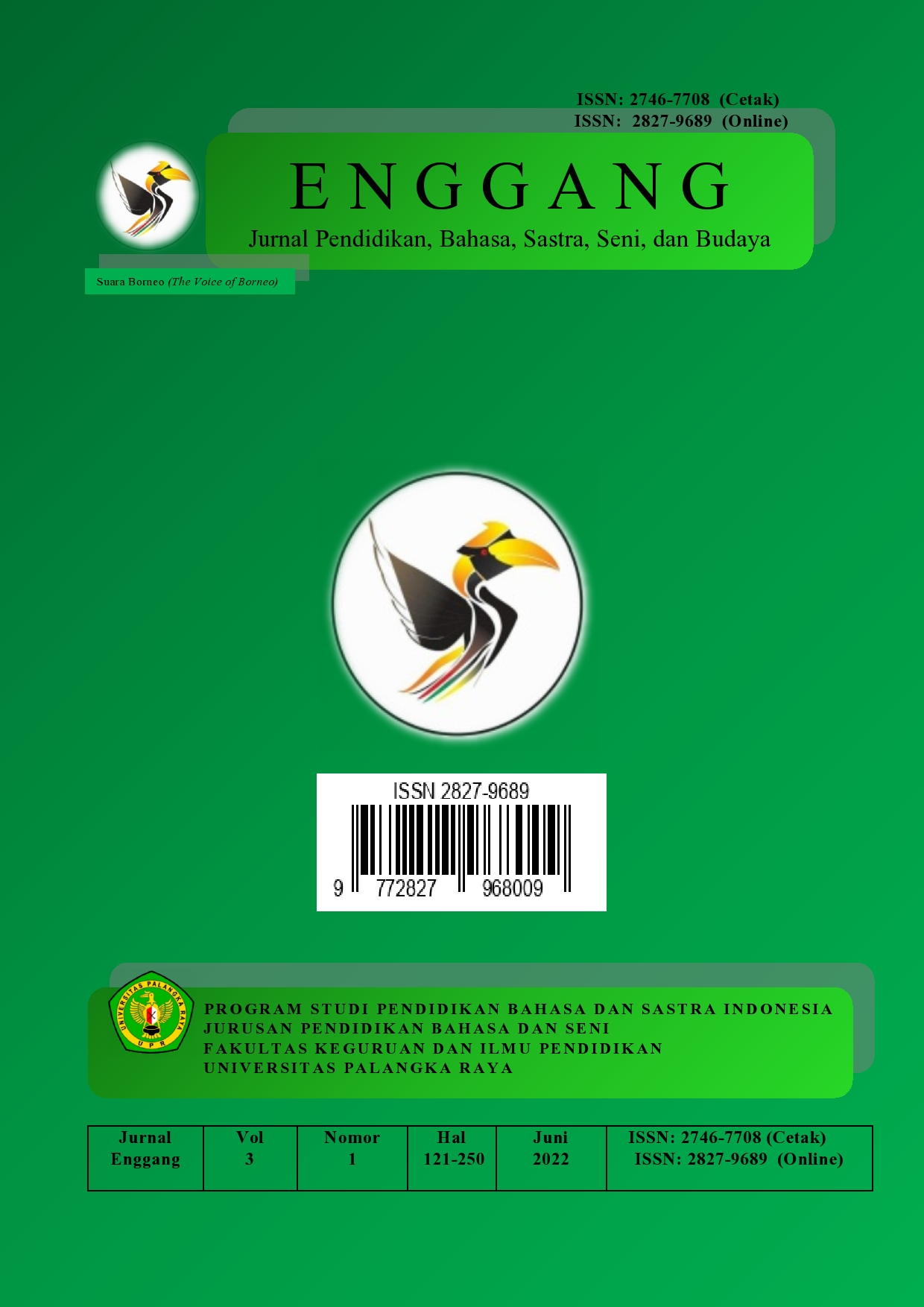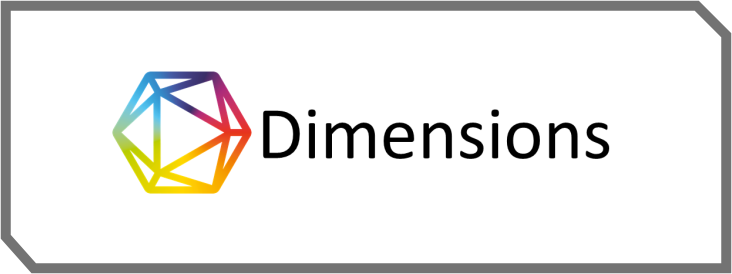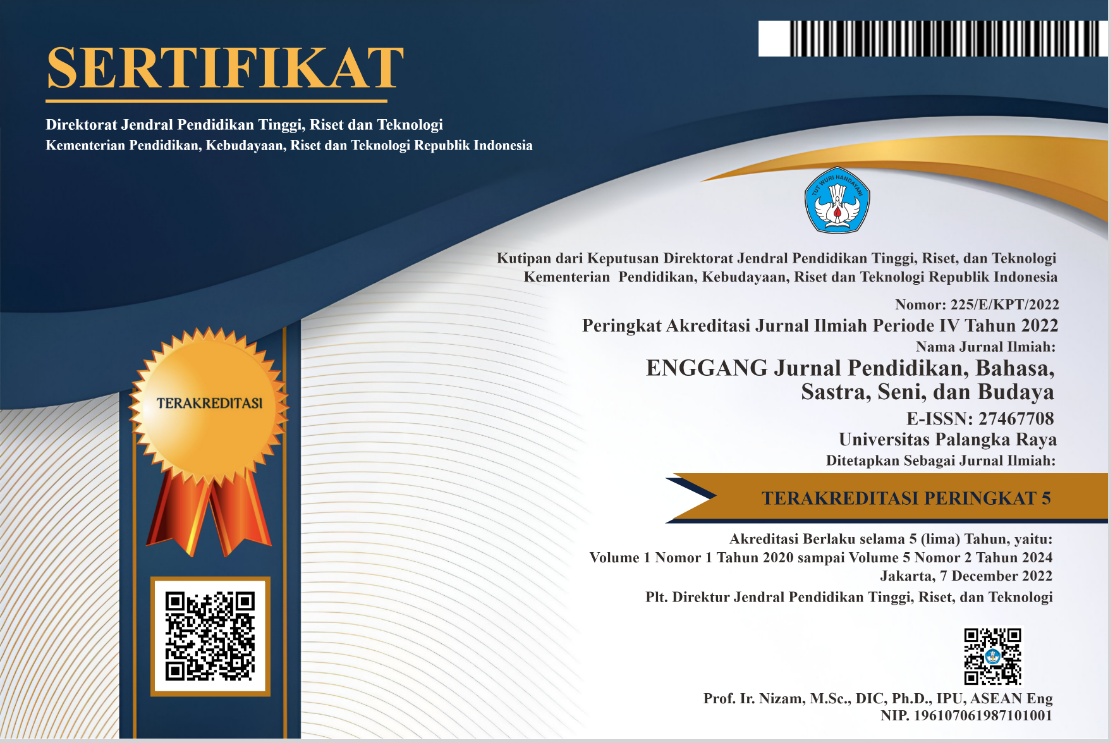Pengaruh Model Pembelajaran Brain Writing Terhadap Kemampuan Menulis Cerita Pendek Peserta Didik Kelas XI SMK Negeri 4 Medan Tahun Ajaran 2023/2024
DOI:
https://doi.org/10.37304/enggang.v5i1.19506Keywords:
Brain Writing, Writing, Short StoriesAbstract
This study aims to determine the effect of the brain writing learning model on the ability to write short stories in class XI students of SMK Negeri 4 Medan. The population of this research is all class XI as many as 286 people. This sample consisted of two classes of 58 students, class XI AV, control class (n = 28), experimental class (n = 28). This research method uses an experimental method with the type of post-test only control group design with a quantitative approach. This instrument is used with an essay test. The results of the study 1) the ability to write short stories in class XI AV3 students (control class) at SMK Negeri 4 Medan using the highest teacher centered learning (TCL) learning model is in the sufficient category with a percentage of 53% of 28 students. 2) the ability to write short stories in class XI AV1 (experimental class) SMK Negeri 4 Medan using the brain writing learning model is in the very good category 53% of 28 students. Thus it is said that the value of the ability to write short stories in the experimental class is higher than the control class. Based on the results of the analysis, the average post-test score for the control class was 61.46 with a standard deviation of 15.12; and the average score of the post-test scores for the experimental class was 84.6 with a standard deviation of 4.23. An increase of 23.14% occurred through the difference in post-test and post-test scores. The results of the calculation of the hypothesis test Tcount = 6.29 with t table at a significant level of 0.05 with df = n-1, df = 28-1 = 27 at a significant level α = 0.05 = 2.051. Because tcount > ttable, the null hypothesis (H0) is rejected and the alternative hypothesis (Ha) is accepted. Based on the results of the analysis above, it can be concluded that there is an influence of the brain writing learning model on the ability to write short stories for class XI students of SMK Negeri 4 Medan in the 2023/2024 Academic Year.
Downloads
References
Arikunto, S. (2013). Prosedur Penelitian Suatu Pendekatan Praktik. Jakarta: Rineka Cipta.
Arikunto, Suharsimi. (2014). Manajemen Penelitian. Jakarta: Rineka Cipta. Bahasa Indonesia SMP/MTs Kelas VIII. Jakarta: PT Gramedia.
Kemendikbud. (2013), Modul 1; Kurikulum 2013 dan Profesionalisasi Bimbingan dan Konseling. Bogor: PPPPTK Penjas dan BK.
Lubis, Joharis, dkk. (2020). Metode Penelitian Pendidikan: Dasar Teoritis dan
Lubis, M. J., & Sari, L. P. (2020). The Online Learning Activities during the Covid 19 Pandemic. 3619–3624.
Misnawati, M. (2023). Melintasi Batas-Batas Bahasa Melalui Diplomasi Sastra Dan Budaya: Crossing Language Boundaries Through Literary And Cultural Diplomacy. Pedagogik: Jurnal Pendidikan, 18(2), 185-193.
Mufarikha, M., & Darihastining, S. (2022, November). Peningkatan Kemampuan Menyimak Cerita Rakyat Pada Siswa Kelas V MI Ghozaliyah Melalui Media Audio. In PROSIDING SEMINAR NASIONAL PENDIDIKAN, BAHASA, SASTRA, SENI, DAN BUDAYA (Vol. 1, No. 2, pp. 30-53).
Putri, F. A., Nasution, K. Z., Lubis, S. H., & Lubis, F. (2023). Analisis Penggunaan Majas Yang Terkandung Dalama Cerpen Berjudul “Patah dan Rasa yang Berdarah” Karya Niam Khurotul Asma. ENGGANG: Jurnal Pendidikan, Bahasa, Sastra, Seni, dan Budaya, 3(2), 300-306.
Rosita, I., Syahadah, D., Nuryeni, N., Muawanah, H., & Sari, Y. (2022, May). Analisis Wacana Kohesi Gramatikal Referensi Endofora Dalam Sebuah Cerpen “Aku Cinta Ummi Karena Allah” Karya Jenny Ervina. In PROSIDING SEMINAR NASIONAL PENDIDIKAN, BAHASA, SASTRA, SENI, DAN BUDAYA (Vol. 1, No. 1, pp. 179-191).
Salwa, N. (2023). Mengembangkan Bakat Menulis Siswa SMK: Strategi Inovatif untuk Menjadi Penulis Cerpen yang Handal. Protasis: Jurnal Bahasa, Sastra, Budaya, dan Pengajarannya, 2(1), 229-244.
Sapriline, S., Mardiana, D., & Simpun, S. (2023). Model Terpadu Buku Cerita Rakyat, Ungkapan dan Peribahasa Berbahasa Dayak Ngaju-Indonesia untuk Sekolah Dasar. ENGGANG: Jurnal Pendidikan, Bahasa, Sastra, Seni, dan Budaya, 3(2), 201-213.
Saputra, N., Misnawati, M., Muslimah, S., Anwarsani, A., Rahmawati, S., & Salwa, N. (2023). Analisis Gaya Bahasa Dalam Cerita Rakyat Oleh Siswa Kelas X SMAN I Damang Batu Serta Implikasinya Terhadap Pembelajaran Sastra di SMA. Protasis: Jurnal Bahasa, Sastra, Budaya, dan Pengajarannya, 2(1), 33-51.
Sugiyono. (2014). Metode Penelitian Pendidikan Pendekatan Kuantitatif, Kualitatif, dan R&D. Bandung: Alfabeta.
Tarigan, Henry Guntur. (2008). Menulis Sebagai Salah Satu Keterampilan Berbahasa. Bandung: Angkasa.
Tohang, V. M., Poerwadi, P., Purwaka, A., Linarto, L., & Misnawati, M. (2023). Campur Kode Dalam Percakapan Komunitas Mahasiswa Di Asrama Lamandau Dan Implikasinya Terhadap Pembelajaran Cerpen Siswa SMA Kelas XI. Atmosfer: Jurnal Pendidikan, Bahasa, Sastra, Seni, Budaya, dan Sosial Humaniora, 1(1), 153-168.
Tritia, A., Poerwadi, P., Diman, P., Hidayat, N., & Mariani, M. (2022, May). Reduplikasi Bahasa Dayak Ngaju Dalam Cerita-Cerita Tambun dan Bungai Serta Implikasinya Terhadap Pembelajaran Bahasa Indonesia di SMA. In PROSIDING SEMINAR NASIONAL PENDIDIKAN, BAHASA, SASTRA, SENI, DAN BUDAYA (Vol. 1, No. 1, pp. 27-45).












